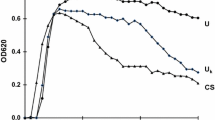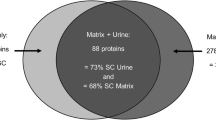Abstract
This study was undertaken to identify proteins which are found associated with calcium oxalate crystals induced in vitro in normal human and rat urine. Crystallization was initiated by adding sodium oxalate individually to each urine sample without centrifugation and filtration. Crystals were collected and analyzed by scanning electron microscopy and X-ray diffraction. Crystal matrix proteins (CMPs) were obtained by demineralization of the crystals with ethylenediaminetetra-acetic acid (EDTA) and analyzed by western blotting technique for immunological identification. Crystals produced in human urine were found to be a mixture of calcium oxalate monohydrate (COM) and calcium oxalate dihydrate (COD) while those produced in rat urine were exclusively COD. CMPs extracted from crystals in human urine comprised, in addition to prothrombin-related proteins, osteopontin and albumin. However, CMPs extracted from crystals in rat urine contained only osteopontin and albumin. Prothrombin-related proteins were found only in trace amounts. In a separate experiment, rat urine samples were supplemented with COM before inducing crystallization. Similar results were observed showing that CMP contained osteopontin, albumin and trace amounts of prothrombin-related proteins. We conclude that several urinary macromolecules including not only prothrombin-related proteins, but also osteopontin and albumin, become associated with CaOx crystals. The incorporation of these proteins in growing stones is not only due to the presence of γ-carboxyglutamic acid as it was suggested for prothrombin-related proteins, but may be due to other factors such as urinary chemistry, presence of glutamic and aspartic acid residues, and calcium-binding sites.
Similar content being viewed by others
References
Boyce WH (1968) Organic matrix of human urinary concretions. Am J Med 45:673
Boyce WH, Garvey FK (1956) The amount and nature of the organic matrix in urinary calculi: a review. J Urol 76:213
Doyle IR, Ryall RL, Marshall VR (1991) Inclusion of proteins into calcium oxalate crystals precipitated from human urine: a highly selective phenomenon. Clin Chem 37:1589
Doyle IR, Marshall VR, Dawson CJ, Ryall RL (1995) Calcium oxalate crystal matrix extract: the most potent macromolecular inhibitor of crystal growth and aggregation yet tested in human undiluted human urine in vitro. Urol Res 23:53
Dussol B, Geider S, Lilova A, Léonetti F, Dupuy P, Daudon M, Berlan Y, Dagorn J, Verdier J (1995) Analysis of the soluble organic matrix of five morphologically different kidney stones. Evidence for a specific role of albumin in the constitution of the stone protein matrix. Urol Res 23:45
Finlayson B, Vermeulen CW, Stewart EJ (1961) Stone matrix and mucoprotein in urine. J Urol 86:355
Fraij BM (1989) Separation and identification of urinary proteins and stone-matrix proteins by mini-slab sodium dodecyl sulfate-polyacrylamide gel electrophoresis. Clin Chem 35:658
Franzen A, Heinegard D (1985) Isolation and characterization of two sialoproteins present only in bone calcified matrix. Biochem J 232:715
Hess B (1991) The role of Tamm-Horsfall glycoprotein and nephrocalcin in calcium oxalate monohydrate crystallization processes. Scanning Micros 5:689
Hoyer JR (1994) Uropontin in urinary calcium stone formation. Miner Electrolyte Metab 20:385
Khan SR, Hackett RL (1987) Crystal-matrix relationships in experimentally induced urinary calcium oxalate monohydrate crystals, an ultrastructural study. Calcif Tissue Int 41:157
Khan SR, Hackett RL (1993) Role of organic matrix in urinary stone formation: an ultrastructural study of crystal matrix interface of calcium oxalate monohydrate stones. J Urol 150:239
Kohri K, Umekawa T, Kodama M, Katayama Y, Ishikawa Y, Takada M, Katoh Y, Kataoka K, Iguchi M, Kurita T (1990) Inhibition effect of glutamic acid and aspartic acid on calcium oxalate crystal formation. Eur Urol 17:173
Kohri K, Suzuki Y, Yoshida K, Yamamoto K, Amasaki N, Yamate T, Umekawa T, Iguchi M, Sinohara H, Kurita T (1992) Molecular cloning and sequencing of cDNA encoding urinary stone protein, which is identical to osteopontin. Biochem Biophys Res Commun 184:859
Leal J, Finlayson B (1977) Adsorption of naturally occurring polymers on calcium oxalate surfaces. Invest Urol 14:278
Lentner C (1982) Units of measurement, body fluids, composition of the body, nutrition. In: Ciba-Geity, 8th edn., Vol 1 p 57
Lian JB, Prien EL, Glimcher JMJ, Gallop PM (1977) The presence of protein-bound γ-carboxyglutamic acid in calciumcontaining renal calculi. J Clin Invest 59:1151
Mckee MD, Nanci A, Khan SR (1994) Ultrastructural immunodetection of osteopontin and osteocalcin as major matrix components of urinary calculi. J Bone Miner Res 9 [Suppl] 1: S379
Morrissey JH (1981) Silver stain for protein in polyacrylamide gels: a modified procedure with enhanced uniform sensitivity. Anal Biochem 117:307
Morse RM, Resnick MI (1988) A new approach to the study of urinary macromolecules as a participant in calcium oxalate crystallization. J Urol 139:869
Morse RM, Resnick MI (1989) A study of the incorporation of urinary macromolecules onto crystals of different mineral compositions. J Urol 141:641
Shevock PN, Khan SR, Hackett R (1993) Urinary chemistry of the normal Sprague-Dawley rat. Urol Res 21:309
Shiraga H, Min W, Vandusen WJ, Clayman MD, Miner D, Terrell CH, Sherbotie JR, Foreman JW, Przysiecki C, Neilson EG, Hoyer JR (1992) Inhibition of calcium oxalate crystal growth in vitro by uropontin: another member of the aspartic acid-rich protein superfamily. Proc Natl Acad Sci USA 89:426
Stacholy J, Goldberg EP (1985) Microstructural matrix-crystal interactions in calcium oxalate monohydrate kidney stones. Scanning Electron Microsc II:781
Stapleton AMF, Ryall RM (1995) Blood coagulation proteins and urolithiasis are linked: crystal matrix protein is the F1 activation peptide of human prothrombin. Br J Urol 75:712
Stapleton AMF, Simpson RJ, Ryall RL (1993) Crystal matrix protein is related to human prothrombin. Biochem Biophys Res Comm 195:1199
Suzuki K, Moriyama M, Nakajima C, Kawamura K, Miyazawa K, Tsugawa R, Kikuchi N, Nagata K (1994) Isolation and partial characterization of crystal matrix protein as a potent inhibitor of calcium oxalate crystal aggregation: evidence of activation peptide of human prothrombin. Urol Res 22:45
Vermeulen CW, Lyon ES (1956) Mechanisms of genesis and growth of calculi. Am J Med 45:684
Warpehoski MA, Buscemi PJ, Osborn DC, Finlayson B, Goldberg EP (1981) Distribution of organic matrix in calcium oxalate calculi. Calcif Tissue Int 33:211
Worcester EM, Nakagawa Y, Wabner CL, Kumar S, Coe FL (1988) Crystal adsorption and growth slowing by nephrocalcin, albumin, and Tamm-Horsfall protein. Am J Physiol 255:1197
Worcester EM, Blumenthal SS, Beshensky AM, Lewand DL (1992) The calcium oxalate crystal growth inhibitor protein produced by mouse kidney cortical cells in culture is osteopontin. J Bone Miner Res 7:1029
Author information
Authors and Affiliations
Rights and permissions
About this article
Cite this article
Atmani, F., Opalko, F.J. & Khan, S.R. Association of urinary macromolecules with calcium oxalate crystals induced in vitro in normal human and rat urine. Urol. Res. 24, 45–50 (1996). https://doi.org/10.1007/BF00296733
Received:
Accepted:
Issue Date:
DOI: https://doi.org/10.1007/BF00296733




